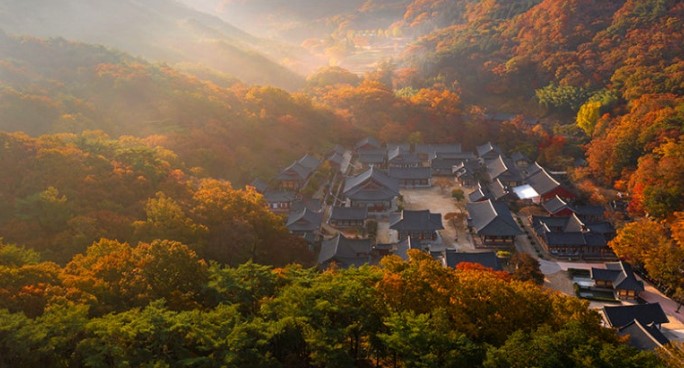
Location: 100 Songgwangsa-ro, Songgwang-myeon, Suncheon, Jeollanam-do, South Korea
History:
Songgwangsa Temple, nestled in the serene mountains of Suncheon, is one of the most important and revered temples in Korea. It is particularly known as one of the “Three Jewel Temples” of Korea, representing the Sangha Jewel (승보사찰), or the monastic community. The temple was originally founded in the late 12th century by the monk Jinul (지눌), who played a central role in the revitalization of Korean Buddhism through the establishment of the Jogye Order. Jinul’s emphasis on disciplined meditation and monastic reform has made Songgwangsa a center for Zen practice in Korea for centuries.
Cultural and Historical Significance
- Sangha Jewel Temple:
- As the Sangha Jewel Temple, Songgwangsa emphasizes the importance of the Buddhist monastic community. Throughout its history, the temple has produced 16 national preceptors (국사), making it a spiritual center for monastic training and leadership in Korea.
- Songgwangsa continues to be a place where monks undergo rigorous training and where Buddhism is actively practiced, making it a living center of Korean Zen (Seon) Buddhism.
- Master Jinul’s Legacy:
- Jinul, the temple’s most famous figure, promoted Ganhwa Seon (간화선), a form of meditation involving critical reflection on key Buddhist concepts or questions (often called koans in Zen). His teachings on sudden enlightenment (돈오) followed by gradual cultivation (점수) remain a cornerstone of Korean Seon practice today.
- Songgwangsa’s influence spread widely throughout the Korean peninsula thanks to Jinul’s reforms, making it a pilgrimage site for devout practitioners and scholars alike.
Main Attractions at Songgwangsa Temple
- Daeungjeon Hall (대웅전):
- This is the temple’s main hall, dedicated to Sakyamuni Buddha, the historical Buddha. The hall features traditional Korean Buddhist architecture, with its elegant wooden structures, colorful dancheong (wooden paintwork), and serene atmosphere.
- Jinul’s Stupa and Memorial Hall (지눌대사의 부도):
- This area commemorates Master Jinul and houses his stupa, where his ashes are enshrined. This sacred area is particularly significant to practitioners of Seon Buddhism who come to pay respects to the influential monk.
- Seungbojeon Hall (승보전):
- A hall that symbolizes the “Sangha Jewel” and enshrines portraits of Korea’s 16 great national preceptors. Seungbojeon stands as a reminder of Songgwangsa’s role in cultivating the monastic community and its leadership over centuries.
- Ssanggyeru Pavilion (쌍계루):
- This is one of the most picturesque spots in Songgwangsa. The pavilion overlooks a peaceful stream and is surrounded by beautiful trees. During the autumn months, the changing leaves provide a stunning backdrop, making it an ideal spot for meditation and reflection.
- Ancient Trees and Forest Trails:
- Songgwangsa is renowned for its old trees and scenic trails that wind through the surrounding mountains. These natural features enhance the sense of tranquility that pervades the temple grounds, making it a wonderful place for quiet contemplation and long walks.
Songgwangsa Temple Stay Programs
Songgwangsa offers temple stay programs that allow visitors to experience Buddhist monastic life firsthand. These programs are designed to help participants relax, meditate, and immerse themselves in the spiritual practices of the temple. Activities typically include:
- Meditation (Seon practice): Participants can engage in Seon meditation, following the tradition of Master Jinul. This practice helps cultivate mindfulness and inner peace.
- Tea Ceremonies: The traditional tea ceremony is an integral part of monastic life, allowing participants to connect with Buddhist values of simplicity and presence.
- Chanting and Monastic Rituals: Visitors can also participate in the temple’s daily rituals, including morning and evening chanting, which offers insight into the rhythms of monastic life.
Natural Setting
- Songgwangsa is located in the foothills of Jogyesan Mountain, offering a serene and secluded environment. The area is especially famous for its lush forests, clear streams, and ancient trees, some of which are over 500 years old. These natural features contribute to the peaceful atmosphere, making Songgwangsa a perfect retreat for those seeking tranquility and spiritual renewal.
- During spring and autumn, the temple is surrounded by vibrant seasonal colors, with cherry blossoms in spring and fiery autumn leaves, making it a visually stunning destination for visitors.
Why Visit Songgwangsa?
- Spiritual Heritage:
As one of Korea’s Three Jewel Temples, Songgwangsa plays a vital role in the history of Korean Buddhism, particularly in the development of the monastic community. Visitors can explore the deep spiritual roots of Seon (Zen) Buddhism and learn about the temple’s role in shaping Korean Buddhist thought. - Cultural and Architectural Beauty:
Songgwangsa’s halls and pavilions, adorned with traditional dancheong (colorful patterns), offer a glimpse into Korea’s architectural and artistic heritage. The temple’s grounds are beautifully integrated into the natural landscape, providing a serene and harmonious environment. - Meditative and Reflective Environment:
Songgwangsa is a peaceful haven for both visitors and monks. The temple stay programs offer a unique opportunity for participants to disconnect from the outside world and reconnect with themselves through meditation, prayer, and simple living.
Tips for Visitors
- Transportation:
- Songgwangsa is about 20 kilometers from Suncheon city. Buses run from Suncheon Bus Terminal to the temple, making it relatively easy to access.
- Best Times to Visit:
- The temple is stunning year-round, but spring (cherry blossoms) and autumn (fall foliage) are particularly beautiful seasons to visit. These natural changes complement the temple’s serene atmosphere.
- Dress Modestly:
- As Songgwangsa is an active monastic community, visitors should dress modestly and respectfully, especially if attending any religious services or rituals.
- Temple Stay Reservations:
- If you’re interested in the temple stay program, it’s best to book in advance, as spaces can fill up quickly, especially during peak tourist seasons.
Songgwangsa is more than just a temple; it is a living institution that has played a central role in the development of Korean Buddhism for over a millennium. Whether you are seeking a spiritual retreat, historical insight, or simply a peaceful environment to relax and reflect, Songgwangsa offers a profound and enriching experience.
